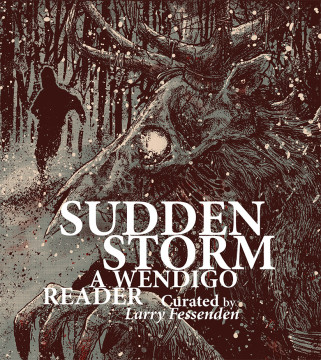
As some of you might remember, a few months ago I wrote pretty extensively about the films of Larry Fessenden. It was a pretty deep dive into the work of a director who effectively shaped my tastes in more ways than I probably realize, both through his own films, and through the ones he godfathered into existence through his production company, Glass Eye Pix. So I jumped when the opportunity came up to interview him about his filmmaking and about the very cool book Sudden Storm: A Wendigo Reader which he curated, a work focusing on the distinctly American myth that has come to be so closely associated with him.

WENDIGO, Director Larry Fessenden on the set, 2002
Sudden Storm collects over a dozen essays, interviews, and script excerpts focusing on the Wendigo myth. Some focus on the pop-culture canon of the creature, of which Fessenden is definitely a prime mover, whereas others focus on the roots of the very myth itself, and how it still creeps within the darkness of the woods of Northern America to this very day. There’s a breadth of knowledge on display that makes this necessary reading for film buffs and for urban legend enthusiasts alike.
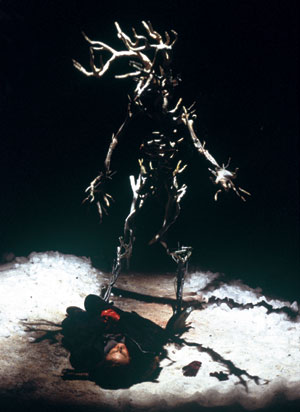
And no one is more enthusiastic about this stuff than Fessenden himself. I was pretty aware of his filmography and of the depth of knowledge each film of his tackles in terms of individual mythologies, but Fessenden’s enthusiasm was practically infectious. A natural raconteur, we talked for a good thirty minutes, and I would have gladly talked to him for thirty hours. In the following interview, we cover everything from how Sudden Storm came together, America’s odd relationship to its own mythology, what technology says about our stories, the sleight of hand that is modern film financing, and the question of ownership in film.
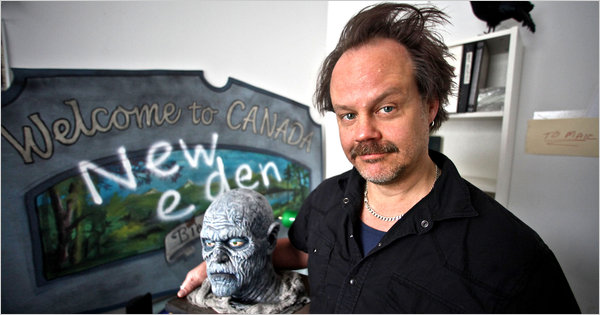
Photo credit: Fred R. Conrad/The New York Times.
Patrick Smith: First and foremost, let’s talk about Sudden Storm, which is a new book that you curated, which is all about the Wendigo myth, which is also the basis for what is, in my opinion, your best known movie, 2001’s WENDIGO. So I guess my first question is: How did this project originally come about?
Larry Fessenden: Well the original movie, very briefly, was generated because I had made a film called HABIT, and I got an award for that, gained some accolades, and so Hollywood said, “what do you have next?” And I had a non-horror project, which seemed to be a terrible strategic move, so I went home after some meetings in Tinseltown and I thought, “Horror, horror, horror… let me think, let me think…” and I realized I had this memory as a child of being told this story of the wendigo creature by a third-grade teacher. And I basically set out to write a script that was a series of memories that had this specter in it, of this “deer-man,” which is how the teacher in third grade had described it. Later on I did some research, and I found out that the wendigo as mythology from the Ojibwe nation really aligned with a lot of my thinking. It’s a cautionary tale about overreach and hubris, and it’s essentially trying to teach the natives not to eat each other in times of extreme duress, in the winter, in the woods, when you’re stranded. “Do not eat your fellow man or you will be possessed by this evil spirit.”
And I feel somehow that speaks also of a greater theme in my thinking about consumption and the way that the white man in general deals with the planet, indigenous people, the poor, the destitute, and so on. So it was a theme that really resonated with me, so I made WENDIGO, I made THE LAST WINTER which also had the wendigo creature, I made another film called SKIN AND BONES, which is another way of looking at the wendigo. Then this press called me and asked me if I wanted to do a book on the mythology, and I thought it would be worthwhile because there are just so many different ways to look at this mythology, that it really is worth exploring. But I didn’t want to write it, I wanted different voices to chime in, and that’s why I became the curator of this little volume.
Patrick Smith: It’s a very diverse group of authors you’ve assembled, everyone from anthropologists to more pop-culture-oriented writers, and you even do an interview with Christian Tizya. Were these all authors you were already aware of, did you have to seek them out, or have people pitch you as the project came into focus?
Larry Fessenden: Well the cool thing is that over the years, because I became associated with the wendigo, I would get e-mails from strangers and scholars. And then by chance, over time if you do a search of yourself now and again, you’d go, “Oh that’s cool, someone wrote a thesis on THE LAST WINTER and how it’s an important environmental story,” so it was really just over time and collecting articles relating to either my own work or to the wendigo itself. I do love the pursuit of clear articulation of this mythology, which is so incredibly elusive, and what I think makes it interesting is that it’s getting at something, but its not entirely clear what, and that’s because it’s [been] through many filters. It’s a very genuine native mythology, that was then sort of usurped by Algernon Blackwood, the famous British writer who wrote the short story “Wendigo.” It’s been in movies and even now TV and comic books, and so there areso many ways to experience the creature. The question becomes: so what is the common theme?
One of my favorite articles is [the one where] I asked Kim Newman, whose a great writer out of the UK to just give me an overview of all the wendigo movies, and that’s one of my favorites because its all about the pop culture resonance. There there are just such a diverse amount of articles that have approached the story from different angles.
Patrick Smith: Yeah, reading the book, the Newman one was one of my favorites too, along with Sam Zimmerman’s, but I’m coming from it from the pop culture side of things, so that’s definitely what I’m going to zero in on.
Larry Fessenden: Yeah, exactly.
Patrick Smith: If we could talk for a minute about the nature of myths, you were sort of talking before about how the white man takes some of these myths, and wraps them around themselves and usurps them. As far as I can tell — American myths are sort of a weird thing. We don’t really have them, except the ones from the indigenous peoples, which were beat down into the ground but refuse to die. So as someone whose worked with other myths, what do you think it is about myths in general that make for good storytelling, in genre or otherwise, and how in America those are used?
Larry Fessenden: My basic theory is that we have to understand how important mythology and basically narrative is to the way we perceive the world, and so by taking vampires and werewolves and analyzing at the same time as enjoying their potency as stories, but also having an eye towards why they’re relevant to us. I think that gives insight into the fact that humanity is driven by a narrative structure, I think that separates us from other creatures. Its important because if the narrative is false or ignites peoples passions for the wrong reasons, it takes us in the wrong direction, then it has a tremendously destructive force, and of course I’m talking about the American political system, the idea of capitalism as the only solution to the design of society. These are all mythologies, it’s important to understand that a lot of the assumptions we make as people going about our business are simply constructs. So I feel that very passionately, and I also enjoy the fun of just telling a story about a creature that will grow because it’s always so hungry.
But that speaks of something very profound, which is our notion that growth is a positive force. You always feel politicians left and right talk about growth –“we have to grow the economy” — well, that’s impossible in a finite world, to continue growth. So maybe, maybe, that’s a mythology that doesn’t make sense. So I think the first thing you have to do is see that you are being manipulated, and that you’re following a mythology, and the next thing is to say, “whats another way to look at it?” So that’s why I think even a little humble volume like Sudden Storm is trying to peel away the onion and just try to understand how we think about the world — “we” meaning society and different people: Indigenous, white man, whatever it is.
So that’s my love of mythology, because on the one hand I’m charmed and captivated by it, and on the other hand, I want to be sure we realize that it is a construct that is guiding our lives, and you have to be able to step outside of it. I always say that my films are actually a critique of religion in some way, and there are many religions that we operate under; the religion of capitalism, Christianity, Judaism, good versus evil, the religion of progress; these are all things that we assume are true, and that the world is built around those, but actually it’s just the way our brain operates. As for American mythologies, I think we’ll find that most profoundly in the Marvel universe, all of those stories are about good and evil, all the superhero movies that we’ve been ideated with are sort of our new Greek gods. There’s lots of people with special powers, some people have a hammer, some people get inside a machine and fly around, that’s our way of processing reality, and to me, all mythologies are simply the way we process reality. And it’s good to know that, so that you can step outside of it and have some control over your passions.
Patrick Smith: I heard a rumor once that you tried going after Werewolf by Night? Is that true?
Larry Fessenden: Oh definitely.
Patrick Smith: Wow.
Larry Fessenden: Funny that Marvel, they’re doing so well, but you can tell that they think that property isn’t worth much. I mean, in a weird way, I love Marvel Comics because I read Tomb of Dracula, the Monster of Frankenstein, and Werewolf by Night. I never really read superhero comics, which is why I think I’m a perpetual outsider outside the cultural norms. Those were beautifully illustrated by Mike Ploog, among many others, but he and Werewolf by Night were always my favorite. Of course I can make my own werewolf story, I don’t need that comic book, but I had some meetings at Miramax back in the day, and I always made it very clear that storyline was very captivating to me. It was just about a guy named Jack who had a badass father who he had problems with, and every month he would turn into a werewolf! It was a great, serialized soap-opera of sorts, and I loved the way that the werewolf was depicted.
But they didn’t want me!
Patrick Smith: [laughs] Well, you never know. Once they get done with this next big batch, they could go a little weird. Chris Evans costs more than they’re willing to pay, and then BAM! Werewolf.
Larry Fessenden: [laughs] Well when they went weird last time, it worked for them, right? Is GUARDIANS OF THE GALAXY even Marvel? I don’t even know.
Patrick Smith: Yup, that’s them.
Larry Fessenden: That was more fun than I was expecting. I understand that CAPTAIN AMERICA: CIVIL WAR was great, but there’s sort of a tiredness to seeing those dudes in suits all the time, its just getting a bit much and they absorb all of our greatest actors. They suck ‘em up and put them in tights. I don’t know what’s going on with that.
Patrick Smith: Well, I guess their thinking is, if you have them, you might as well lock them down.
Larry Fessenden: Well, I can’t blame them.
Patrick Smith: To backpedal a little bit, you were talking about myths in the modern context of the political system, or attaching them to these larger structures, so I’m wondering how you think myths will interact with technology? Out of curiosity, did you see UNFRIENDED?
Larry Fessenden: No, but I actually — that was a terrifying trailer, and I wondered if it was a good movie, but I didn’t see it.
Patrick Smith: It’s definitely interesting, the reason I bring it up is because it basically creates a new kind of ghost story based in technology. Basic idea is, if you accept a chat message from someone who’s dead, that ghost can now haunt you through your computer. I don’t know if that was a real urban legend before, but it’s definitely a thing now.
Larry Fessenden: Well, some of the Japanese horror used that — obviously RINGU was about the TV and the videotapes and those things haunting you — it’s only logical that we have these kind of stories. I think it’s essential.
What I love about horror is that it really has to speak to the time, and it’s one of the reasons I’ve often criticized remakes, because they are sort of dredging up stories that were right for the era but maybe aren’t as relevant now. So UNFRIENDED, even though it’s not a movie I saw, I immediately liked where it was going, because it was making something vital and common in kids’ lives and finding the threatening element in there, which is always worth finding, because there’s always the dark side in our most beloved institutions.
And I just like bringing that up and making people think about what they take for granted!
Patrick Smith: Yeah, and sometimes these things interact with the real world in real ways. Like that documentary coming out about the SLENDERMAN.
Larry Fessenden: Yeah! Funny you mention that — I was just talking about SLENDERMAN. I don’t know a whole lot about the backstory, I just briefly watched at least one version of some of the YouTube stuff, but in general, I just like that that exists out there. Its creepy and — look, it’s an aesthetic thing to like horror, and to like the spooky things in the world, and technology does not exempt us from those things. In fact, it’s very creepy and insidious and all in our lives, so it’s appropriate to write stories about our interaction with all this new creepy stuff. It doesn’t have to be a creaky old house to be scary.
Patrick Smith: I don’t think there’s any real comparison — Internet’s already scarier than we can think up.
Larry Fessenden: Well, that’s frickin’ true. The thing about the internet that’s scary is that it speaks to the madness of crowds, and the debasing of face-to-face dialogue, which allows people to feel empowered as they sit at home getting irate, as we all do, about the littlest things. But when you don’t have to look someone in the eye and follow through on your outrage, then you can keep fueling that discontent. Whereas, usually if you’re sitting in a room with someone, you can kind of go, “Ah, well listen, we’re all in this together!” So it’s ironic that the internet connects us, and it alienates us from each other, and I think these are very serious issues that society isn’t entirely able to deal with, because it’s coming at us so fast. Always with a smile, always with a great new product from Apple, and yet it’s important to be a little wary of, once again, the mythologies that run our lives. Which is that every new shiny bauble is good, every new technology is advancing society… but is that true? Is it possibly disconnecting us from each other, is it possibly making us feel alienated and more violent?
Patrick Smith: Its a good question, and honestly I don’t have an answer. Although my default is “Yeah, the internet’s gonna bring us down” but I’m a big TERMINATOR fan, so of course I’m going to believe that.
Larry Fessenden: [laughs] Exactly. Well the beauty is that we’ve all been raised — or at least our circle of perverted crazy people of horror and sci-fi — we’ve lived and breathed cautionary tales since before FRANKENSTEIN, since Prometheus. That’s the thing I love about horror and the darker genres, is that it really looks humanity in the face and says “Are we doing all of this correctly? Are we not succumbing to our weaknesses? Will this all blow up in our face?” It’s amazing that FRANKENSTEIN remains such a vital myth, because it really says, “Do we now what we’re doing with science and technology?”, assuming it’s always for the good. So these are great questions to ask, and yeah the whole TERMINATOR thing, and all of these wonderful scary movies ask that question: “Are we doing it right?”
Patrick Smith: Those questions generally anchor most of my favorite movies in the genre which, incidentally, you’ve had a hand in more than a few as a producer through your company Glass Eye Pix. Looking at your IMDB page, the amount you’ve been involved in, from acting to producing, is pretty astonishing. However, it’s become pretty clear that distribution models have changed pretty radically in the last five to ten years. Video stores aren’t really a thing anymore, DVD sales overall aren’t great, so it seems like it’s all coming down to theatrical or VOD. So I’m curious, as a producer, how you get these films financed, and maybe even get a little money in the bank for yourself.
Larry Fessenden: Well, you’re absolutely accurate in your questioning. It used to be that I could invest my own Glass Eye coffers into a film, and then I would double the money, or at least make it back, and that gave me reason to go forward with the next project. That was a glorious period in the early 2000s, video was looking for content, and it was really a great period, and it’s why I think in the analysis of it all, I was able to establish Glass Eye Pix and make movies for myself, and with people like Ti West, Graham Reznick, Jim Mickle, and Glenn McQuaid.
[Pause] Now you need a very direct relationship with Netflix and stuff, so I don’t feel quite as set up or assured. Those are major companies, and they’re quite generous, but you usually need a middle man, and it’s changed things a little. I’ve been fortunate enough to have an association with MPI, which is also known as Dark Sky Films, and I’ve made about six movies with them over the years, and in that case they’re providing me with the budget. Obviously I’ll skim a little off the top for operating costs, and that’s how we stay afloat and make some really great movies. But I don’t own those movies in the same way I owned my earlier films. So everything different, my own films like HABIT, WENDIGO, THE LAST WINTER… those are now all under one roof at IFC, and I get to share a little participation when they sell those. So I’m like a hobo, just going from one possible opportunity to another, trying to keep new talent protected from the harsh winds of the marketplace and to stay afloat myself. It’s rough, it doesn’t get any easier, since everything keeps changing, and you keep having to figure it out.
Patrick Smith: So if you own those, does that mean you don’t own BENEATH? Which is a movie I liked quite a bit, but I know it got roughed up a little bit —
Larry Fessenden: [laughs] That movie was severely maligned, and maybe misunderstood. There were a few snarky reviews which I think kind of sunk it, if I can use the term, but there were also some thoughtful people that didn’t like it. I’ve always appreciated those that see it as a nasty little satire, or whatever they got out of it, because I think it’s a cool movie and I love the kids that are in it. One of the weird knee-jerk things is people saying, “Its terrible acting!” and I reject that completely.
In any case, it’s a soft spot for me, because it’s the first movie I made in what I’ll call the “trolling generation” –I came out of the theater and felt really great about my screening, and within two and a half minutes, I had two jackasses reviewing it like it was the worst movie ever made, which to me felt utterly silly. You just sort of realize the ego involved in internet culture, just quick snarky commentary. And listen, I’m not a lone victim of that. Everybody feels the burn, just really being dressed down and the whole culture has gotten preposterously unthoughtful.
But the answer is I made BENEATH for Chiller Films, which was a good experience. We got a pretty good budget, but it was still a strain to make a film on the water and all that, but as far as going in knowing it was a low-budget movie, we did pretty well. But that was truly a work-for-hire, it wasn’t my script, which was very different from my own films, which were produced independently, which I had a bit more say in how they were put out.
Patrick Smith: So going into the future, I would imagine you’ll direct again, so would you do work for hire again, or try and stick with what you’ve done before and control what you make completely? Or would it depend on the project?
Larry Fessenden: It would depend on the project, depend on the script. I will add that there’s no such thing controlling the work completely, because if you’re a responsible artist, you have to be aware of the realities. Either the investor has concerns about your cast, your ending, your storyline, your budget, so you’re always mindful of the two worlds of commerce and the arts, and they can live very happily together. Everybody knows I’m a fan of Hitchcock — he felt great responsibility towards his investors, and I always do too. At the same time, you have to protect the artistic impulse, the only things that are exciting are those that come unexpectedly from individual voices in the arts. To make movies by committee, and to try to anticipate and pander to an audience, is simply to fill the air with deadening work. So it’s very very important, as a matter of principle, to protect the artistic vision.
Anyway, thats how I’ve always looked at it, but I would direct someone else’s script. It’s all just circumstance. In the end, and I appreciate you asking, because I really I’m here to make my own stories, because they are quite specific to me and my own sense of what cinema can be. And that’s why I defend other artists, because I think my vision should also be defended. BWA-HA-HA!
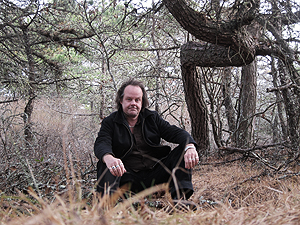
To find out more about Larry Fessenden’s work, make sure to check out the GLASS EYE PIX website, where you can find news on all of his upcoming projects and those of the extended Fessenden filmmaking family. If you’d like to show your support, buy something from the company’s store, which has everything from movies, mugs, seasons of his critically acclaimed audio play series TALES FROM BEYOND THE PALE, and even kinky advent calendars.
To buy a copy of SUDDEN STORM: A WENDIGO READER, check out the publisher’s FIDDLEBLACK website to order directly from them.
A sincere thanks to Mr. Fessenden for taking the time to let me talk to him, and thanks to Fiddleback editor Jason Cook for setting this talk up and for bearing with me throughout the long transcription process.
Tags: Algernon Blackwood, Fiddleblack Press, Glass Eye Pix, Horror, Icons, Interviews, Larry Fessenden


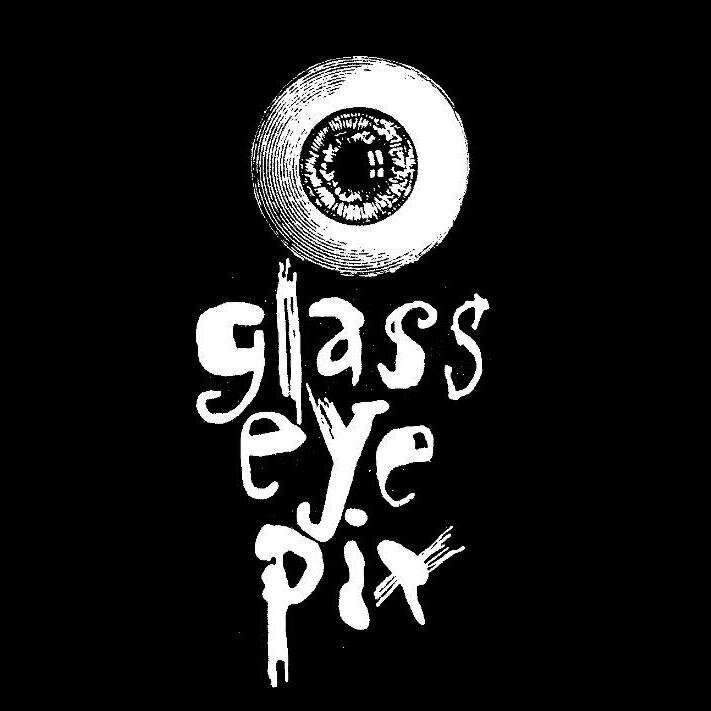

No Comments